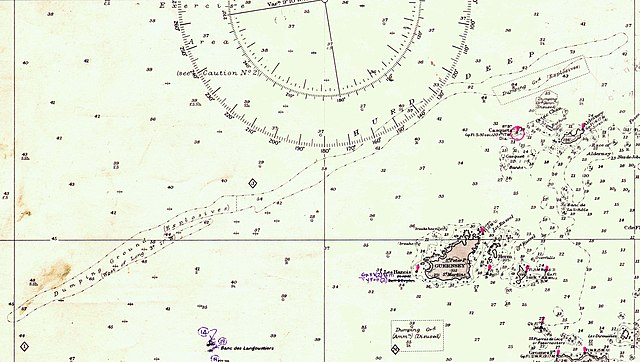Top Qs
Timeline
Chat
Perspective
Hurd's Deep
Underwater Valley in the English Channel From Wikipedia, the free encyclopedia
Remove ads
Hurd's Deep (or Hurd Deep) is an underwater valley in the English Channel, northwest of the Channel Islands. Its maximum depth is about 180 m (590 ft; 98 fathoms), making it the deepest point in the English Channel.


Remove ads
Toponym
The feature was named after the British Royal Naval Captain Thomas Hurd (1747–1823), who was the second Hydrographer of the Navy. It was chosen by the RN marine cartographer Admiral Martin White.[1]
Geology
Summarize
Perspective
Hurd's deep began to form in the Pleistocene of the late Quaternary period (in the last 750,000 - 500,000 years). Successive melting periods after ice ages caused water to gouge out a deep water trench through a river valley system that now forms the seabed in the eastern part end of the English Channel. At some point a catastrophic flood from the southern North Sea basin created Hurd's Deep. It's believed that the collapse of a chalk ridge that once dammed the Strait of Dover let flood waters from a huge proglacial lake flow through the former river systems scouring down to the bedrock forming the trench.[2][3]
During the Last Glacial Period, which ended 11,700 years ago, sea levels dropped again to the point that the English Channel became an area of river valleys. Due to its depth, Hurd's Deep likely remained flooded by seawater. It might have been a glacial refugium.[4]
Hurd's Deep has an approximate length of 150 kilometres (80 nautical miles) with a width of between 2 and 5 km (1 and 2+1⁄2 nmi). It terminates abruptly at the western end. The seafloor around the trench is typically flat with a depth range of 70–90 m (230–300 ft; 40–50 fathoms). But within the trench the maximum depth is 170 m (560 ft; 93 fathoms).[5] Hurd's Deep is the deepest point in the English Channel.[6]
Remove ads
History
Deep sea ordnance disposal
Following the First World War, Hurd's Deep was used by the British Government as a dumping ground for both chemical and conventional munitions.[7] Following the Second World War, it was used to dump military equipment, munitions and weaponry left behind by the ousted German invaders of the Channel Islands.[8] Routine dumping of British munitions carried on until 1974.[7][9][a]
Between 1946 and 1973 the area was also used for the dumping of low- and intermediate-level radioactive wastes. 28,500 barrels of waste – including plutonium, which has a half-life of 24,100 years – were disposed of into the Deep during this period.[10][11]
Wrecks
SMS Baden was scuttled there in 1921.[12] The British submarine HMS Affray sank in Hurd's Deep in 1951 with the loss of 75 lives.[13]
In popular culture
In Harry Collingwood's science fiction stories about the Flying-Fish airship-submarine, the Flying-Fish is hidden in Hurd's Deep between adventures.[b]
Citations
Further reading
Wikiwand - on
Seamless Wikipedia browsing. On steroids.
Remove ads
